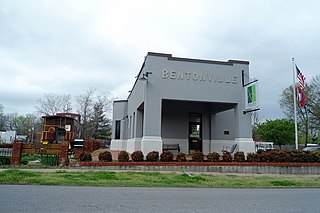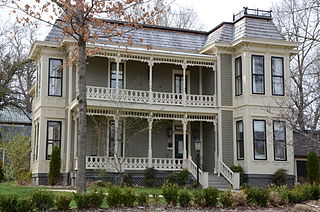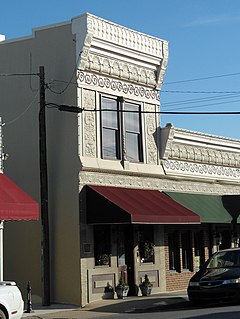
Old High Middle School is in the building which was once Bentonville High School, and is located at 406 NW 2nd Street, Bentonville, Arkansas. Construction costs when it was built in 1928 were $25,000. It was designed by John Parks Almand, in a combination of Spanish Colonial, Mission and Mediterranean styles.

The Benton County Courthouse is a courthouse in Bentonville, Arkansas, United States, the county seat of Benton County, built in 1928. It was listed on the National Register of Historic Places in 1988. The courthouse was built in the Classic Revival style by Albert O. Clark and anchors the east side of the Bentonville Town Square.

Albert Oscar Clark (1858–1935), commonly known as A.O. Clark, was an American architect who worked in Arkansas in the early 1900s.

The Bentonville Train Station is a former train station in Bentonville, Arkansas. Built in 1925 on Main Street, the train station served a short connector line that connected Bentonville to the St. Louis and San Francisco Railway (Frisco) to the east in Rogers, and the Kansas City, Pittsburg and Gulf Railroad to the west in Gravette. The building was listed on the National Register of Historic Places (NRHP) in 1988.

John Parks Almand was an American architect who practiced in Arkansas from 1912 to 1962. Among other works, he designed the Art Deco Hot Springs Medical Arts Building, which was the tallest building in Arkansas from 1930 to 1958. Several of his works, including the Medical Arts Building and Little Rock Central High School, are listed on the National Register of Historic Places.

Downtown Bentonville is the historic business district of Bentonville, Arkansas. The region is the location of Walmart Home Office; city and county government facilities; and most of Bentonville's tourist attractions for the city and contains many historically and architecturally significant properties. Downtown measures approximately 1.5 square miles (3.9 km2) and is defined as the region between Tiger Boulevard to the north, Highway 102 (AR 102) to the south, Walton Boulevard to the west and J Street to the east. Similar to other central business districts in the US, Downtown has recently undergone a transformation that included the construction of new condos and lofts, renovation of historic buildings, and arrival of new residents and businesses. Upon opening of Crystal Bridges Museum of American Art the increased tourist traffic related to the museum has made Downtown Bentonville one of the state's most popular tourism destinations.
U.S. Highway 71 is a U.S. highway that runs from Krotz Springs, LA to the Fort Frances–International Falls International Bridge at the Canadian border. In Arkansas, the highway runs from the Louisiana state line near Doddridge to the Missouri state line near Bella Vista. In Texarkana, the highway runs along State Line Avenue with US 59 and partially runs in Texas. Other areas served by the highway include Fort Smith and Northwest Arkansas.

The Rice House is a historic house at 501 NW "A" Street in Bentonville, Arkansas. It is a 2+1⁄2-story wood-frame structure with elaborate Eastlake styling. Characteristics of the style include jigsaw-cut bracketing, spindled balustrades, and molded panels under the windows. At the time of its construction in 1890, it was considered one of Bentonville's grandest houses. The house was listed on the National Register of Historic Places in 1988.

The Bentonville Third Street Historic District is a residential historic district just southeast of the central business district of Bentonville, Arkansas. It covers two blocks of SE Third Street, between Main and B Streets, including fourteen properties on Third Street and adjacent cross streets. This area, developed principally after the arrival in Bentonville of the railroad in 1881, is reflective of the high-style architecture of the late 19th and early 20th centuries that had not previously been widespread in Benton County. All of the houses are one to 2+1⁄2 stories in height, and all are wood frame, except the Elliott House, a brick house with an eclectic combination of Italianate and Second Empire styles.

The Bentonville West Central Avenue Historic District is a residential historic district west of the center of Bentonville, Arkansas. Located along West Central Avenue between A and G Streets stand forty houses, most of which were built between 1885 and 1935. They represent a concentration of the finest residential architecture of the period in the city. The houses are stylistically diverse, including two Italianate houses and six Craftsman houses. Notable among the former is the Craig-Bryan House, a brick structure that also has Gothic vergeboard decoration.

The Breedlive House and Water Tower are a historic residential property on the south side Benton County Route 4 east of Bentonville, Arkansas, about 1.1 miles (1.8 km) east of its junction with Arkansas Highway 72. The two-story house is a c. 1887 brick structure that was enlarged and restyled c. 1907, giving it a mix of original Italianate and Eastlake detailing, and a front Colonial Revival two-story porch. The property includes a 28-foot (8.5 m) square brick tower, built c. 1920 as a water supply for an apple orchard. The tower is the only structure surviving in the county from the period known to be associated with the then-significant apple industry.

The Charles R. Craig Building is a historic commercial building at 113 South Main Street in downtown Bentonville, Arkansas. It is a brick two story building, clad in stucco and a distinctive pressed metal facade with Italianate styling. It was built c. 1900 by Charles Craig, a real estate broker and merchant. The building was later occupied by J. W. Blocker, who owned the Bentonville Apple Evaporator. It is believed that he installed the large walk-in safe on the premises. It continues to be used for housing professional offices.

The Elliott House is a historic house at 303 South Third Street in Bentonville, Arkansas. It is a large three-story brick house with Italianate style, built in 1887 for Harry Elliott, who made a fortune investing in silver mines in Silver City, New Mexico. The house is distinctive for its use of brick on the interior as well as exterior walls; those on the inside are 8 inches (20 cm) thick, those outside are 16 inches (41 cm). The exterior features include seven porches, a widow's walk, and carved brackets in deeply overhanging eaves.

The Henry-Thompson House is a historic house at 302 SE Second Street in Bentonville, Arkansas. It is a two-story brick building, with Italianate styling that includes trusswork in the front-facing gable, a scrollwork balustrade on the main porch, and scrolled brackets on a hood over a secondary entrance. Built in 1890, this is a good representative of late Italianate style brick homes that were built in significant numbers in Bentonville between 1870 and 1895.

The Linebarger House is a historic house at 606 West Central Avenue in Bentonville, Arkansas, U.S.A. This two-story Craftsman-style house was built in 1920 by C. A. Linebarger, one of the principal developers of the Bella Vista resort area north of Bentonville. As one of the first Craftsman houses built, it played a significant role in popularizing the style in the region, with a deep porch whose roof is supported by stone porch piers, wide eaves with decorative supporting brackets, and exposed rafter tails.

The Macon-Harrison House is a historic house at 209 NE Second Street in Bentonville, Arkansas. Built in 1910, it is a large two-story brick structure with limestone trim, including corner quoining, porch columns and balustrades. This high-quality late Victorian house was built by John Macon, who profited from the local apple industry by building an applejack distillery. Macon reportedly built it as a wedding gift for his bride.

The Maxwell-Hinman House is a historic house at 902 NW Second Street in Bentonville, Arkansas. It is an elaborate L-shaped Italianate brick house, supposedly built in 1881 by a returning Civil War veteran. It has decorative brickwork brackets, cornice, corner quoining, and window hoods. The only significant woodwork on the exterior are the porch columns which have ornate scrollwork capitals. The high quality work and unusual decorative elements suggest the house was built by workmen from outside the area.

The Morris House is a historic house at 407 SW Fourth Street in Bentonville, Arkansas. Built c. 1855, this single-story frame structure is one of the few surviving pre-Civil War structures in Benton County. It has a side gable roof, narrow clapboard siding, a wide frieze board, and capped corner boards giving a hint of Greek Revival styling. Its original owner and exact construction date are not known.

The Col. Samuel W. Peel House is a historic house museum, also known as the Peel Mansion Museum, at 400 South Walton Boulevard in Bentonville, Arkansas. It is a two-story stuccoed brick masonry structure, with a three-story hip-roofed tower at the center of its front facade. The house was built c. 1875 by Samuel W. Peel, a prominent local politician and businessman. After serving in the Confederate Army in the American Civil War, Peel studied law and practiced for many years in Bentonville. He served several terms in the United States Congress, and helped establish the First National Bank of Bentonville. Despite later alterations, the house is one of the finest Italianate mansions in the region.

The James A. Rice House is a historic house at 204 Southeast Third Street in Bentonville, Arkansas. It is a 2+1⁄2-story brick structure, with tall arched windows and a bracketed cornice typical of the Italianate style. It has a two-story porch, asymmetrical massing, and a steeply pitched roof with cut-shingle gable finish typical of the Queen Anne style, which was in fashion when it was built c. 1879. Its builder and first owner was James A. Rice, a local lawyer who served two terms as mayor.




















